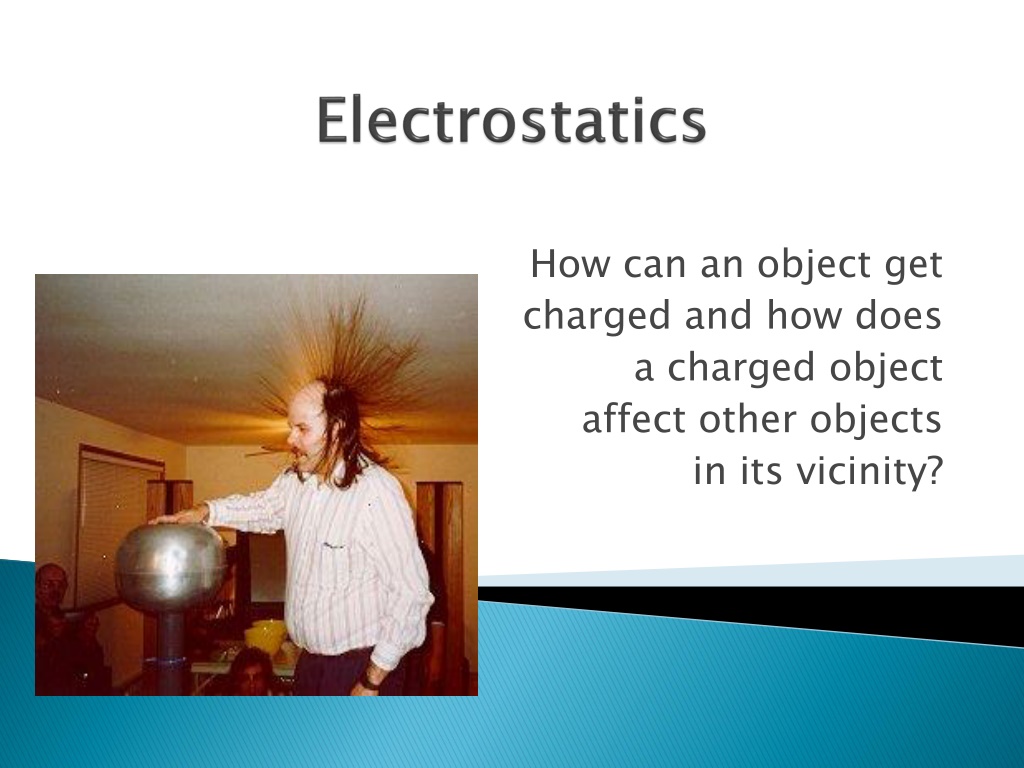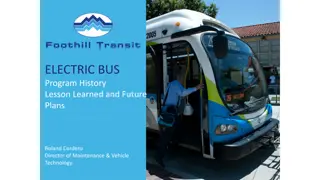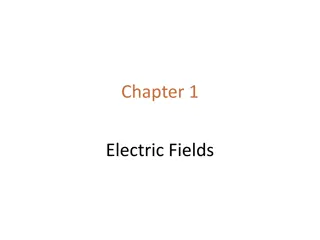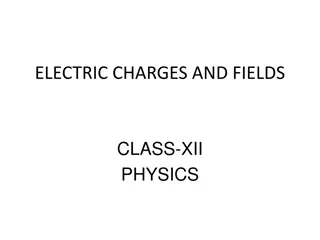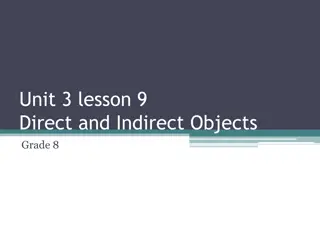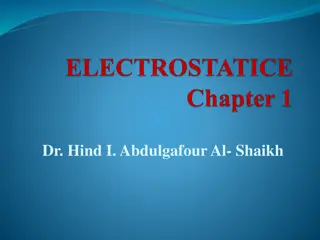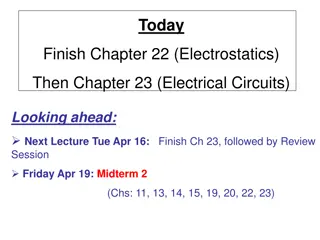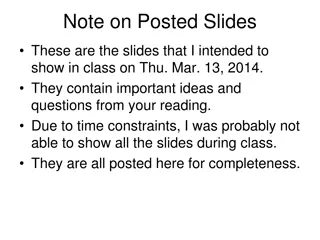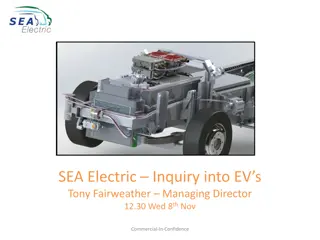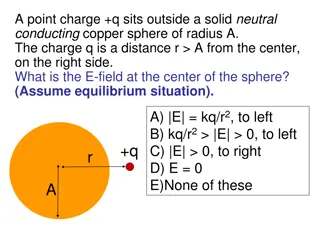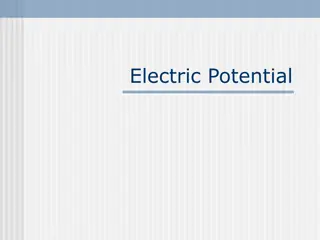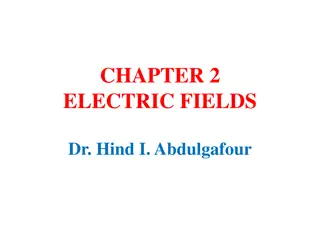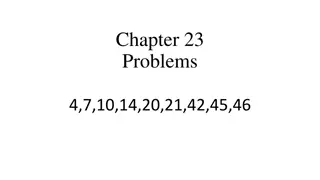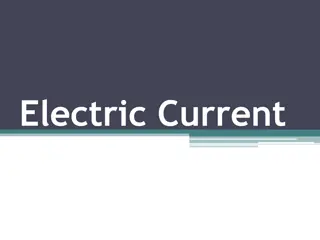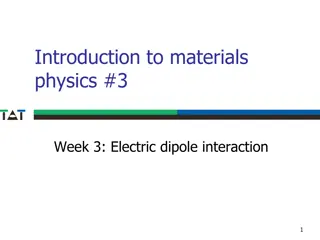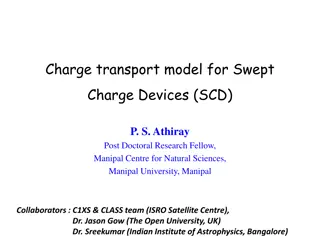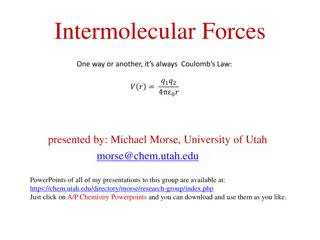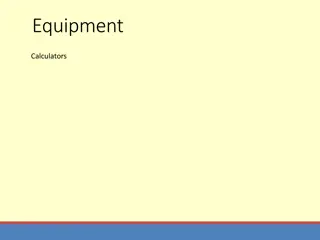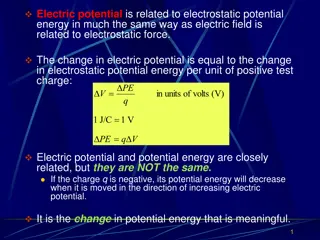Understanding Electric Charge and Interactions Between Objects
Matter is composed of neutrons, protons, and electrons with different charges. Being charged means having an excess or shortage of charge. Grounding, insulators, conductors, and methods of charging play important roles in how objects get charged. By contacting charged objects with objects that can give or receive charges, the process of uncharging can occur. Good conductors allow charges to flow with little resistance, while good insulators impede charge flow. Understanding these concepts helps explain how charged objects interact with each other and their surroundings.
Download Presentation

Please find below an Image/Link to download the presentation.
The content on the website is provided AS IS for your information and personal use only. It may not be sold, licensed, or shared on other websites without obtaining consent from the author. Download presentation by click this link. If you encounter any issues during the download, it is possible that the publisher has removed the file from their server.
E N D
Presentation Transcript
How can an object get charged and how does a charged object affect other objects in its vicinity?
What makes up all matter? What does it mean to be charged ? What is GROUNDING? What are insulators & conductors? What are the (names &) methods of charging? Hey wait, what IS charge? A measurement, a concept .? What do charged objects do? (to other objects)
Matter is made of Neutrons, Protons and Electrons Protons have POSITIVE charge Electrons have NEGATIVE charge Neutrons are uncharged Which has more charge? Being charged means having an excess or shortage of __________ Which charges move Why do they move? move to charge an object?
This term is used for the process that un- charges a charged object. It is performed by contacting a charged object to an object that can give, OR receive ___________ charges, so that the initially charged object is made neutral. It can (partially) happen w/o contact when one object that is highly charged discharges across a gap that is a spark
A good CONDUCTOR allows negative charges to travel around through the material making up the conductor, with very little RESISTANCE. A good INSULATOR makes it very hard for negative charges to travel around through the material making up the insulator. These have a lot of RESISTANCE. A SUPERCONDUCTOR is a material that allows negative charges to flow through it without any RESISTANCE.
What happens when fur is rubbed on the rubber wand? Cloth on the glass wand? What happens when the wand is brought near a metal bar or gray sphere? Why? What happens when the wand touches the metal bar or gray sphere, and then is held near? Why? What happens when the two gray spheres that have been touched by the same wand are brought near each other? Why? What happens when the two gray spheres that have been touched by different wands are brought near each other? Why? What happens if someone touches the metal bar or spheres after they have been touched by a wand?
Charging by : Friction Materials rubbed against each other transfer Friction Conduction A charged object is brought in contact with a conductor and there is a transfer of Conduction Induction A charged object is brought NEAR a conductor, the conductor is grounded, there is a transfer of .. the ground is removed, and finally the charged object is moved away from the conductor Induction Polarization A charged object is brought near a neutral conductor, electrons on the conductor move (toward, or away from the charged object) and then the polarized object behaves as if it has the ________ charge as the object that caused the polarization. Polarization (not really charging, as a polarized object s NET charge can be zero not really charging, as a polarized object s NET charge can be zero)
1. Use the negatively charged wand to charge the electroscope by CONDUCTION (needs contact). Remove the wand, then bring it back near scope. You observe: Charge the glass with the cloth. Bring it near the charged scope. You observe: 2. Ground scope. Use the negatively charged wand to charge the electroscope by INDUCTION (no contact with charged wand, but a ground must be connected and disconnected at the appropriate time. Remove the wand, then bring it back near scope. You observe: Charge the glass with the cloth. Bring it near the charged scope. You observe: 3. Record the four steps to charging the scope by induction. Do you know what goes in in each of the four steps? These are found in Lesson 2b on PCR
The SI unit for charge is the COULOMB (C) The charge of one electron is -1.6x10-19C The charge of one proton is +1.6x10-19C The quantity of charge equal to 1.6x10-19C is often written as e e so the charge of one electron is e To calculate the charge of a certain number of electrons or protons, use the equation: Q = +ne where Q is quantity of charge, and n is the # of charge carriers
https://www.youtube.com/watch?v=nwnjYERS66U https://www.youtube.com/watch?v=nwnjYERS66U
To calculate the charge of a certain number of electrons or protons, use the equation: Q = +ne *where Q is quantity of charge, and n is the # of charge carriers *e = 1.602 x 10-19C * The mass of an electron was also determined to be 9.11x10-31kg
If sphere on a VanDeGraaf generator is charged to10,000 volts, it has had 1.74x1012 electrons moved off of it. What is the charge of the sphere (sign and number)?
Opposite charges attract and like charges repel Charged objects can attract neutral objects, by polarizing the neutral objects. Conductors are easy to polarize, insulators are not easy to polarize. Electrons are the only charges to get transferred The force mathematically described by Coulomb s Law force between charged objects can be
Review Electroscope Investigation PCR Static Electricity Lessons 1&2 CYU Lesson 1: a(1), b(1-6), c(all), d(1-3), e(1,2,4,5,6) Lesson 2: a(3,4), b(4), c(all), d(all) Quest: Electrostatics
1. If one million electrons are added to the top of a Van de Graff generator, what is its charge in coulombs? 2. Use the negatively charged wand to charge the electroscope by INDUCTION. Remove the wand, then bring it back near scope. You observe: Charge the glass with the cloth. Bring it near the charged scope. You observe: 3. Check the four steps to charging the scope by induction. Do you know what goes in in each of the four steps?
But wait, what IS force? When does an electric force occur? What factors affect the size and direction of the electric Force on an object?
What is the mathematical relationship between electric force quantity of charge quantity of charge distance electric force (in newtons) and the: quantity of charge A (in coulombs)? quantity of charge B (in coulombs)? distance (in meters) between charges A & B?
|Fe|(N) and QA(C)? (What if you double, triple, QA) |Fe|(N) and QB (C)? (What if you double, triple, QB) |F Fe e|(N) and d (m)? (N) and d (m)? F Fe eis electric force d is distance between the electric charges is electric force d is distance between the electric charges Use the Gizmo simulation: Coulomb Force Google Username: Password:
Fe= k(Q1Q2)/d2 Fe: k = 9 x 109(Nm2/C2) d: Q1& Q2are:
The concept of a field scientists to explain the surprising force phenomenon that occurs in the absence of physical contact. field is utilized by
The electric field is a ratio, comparing the size of the force on a charged object to the size of the charge E=Fe/Q Fe=EQ A slightly charged object in an electric field will experience a small electric force, while a heavily charged object will experience a ____________ force.
As the distance from a charged object doubles, the electric field ________________ Ex: If a small test charge is 0.40m from the center of a charged Van de Graff, it experiences an electric force F. How big is the force when the test charge is: a) 0.80 from the center? b) 1.20m from the center? c) 0.20m from the center?
The field lines are really arrows that show the direction of force on a positive test charge, and show field strength by how closely the lines are spaced
Electric Field Lines for Two (different, isolated) Point Charges
Skim PCR Static electricity 4C, and complete the CYU questions Complete WS on Electric Fields Play Electric Field Hockey Google Phet, go to play with sims, Physics, electricity
If the electrons from one gram of hydrogen were placed in a container and taken to the South Pole, and the protons from the same gram of hydrogen were placed in a container and taken to the North Pole, How much force would these two containers exert on each other?
